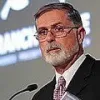“Born Again” is Not a Figure of Speech
The Term “Born Again” Confuses Many Today Because They Reduce It To A Mere Figure Of Speech, A Metaphor For A Spiritual Awakening.

- Mark R. Rushdoony
The term “born again” confused Nicodemus two millennia ago because he tried to apply it to natural birth. It confuses many today because they reduce it to a mere figure of speech, a metaphor for a spiritual awakening.
The term “born again” is not just a metaphor. In a metaphor, a word or phrase that properly describes one thing is used to describe another. “Computer memory” is a metaphor. Whatever storage devices computers have, we know they are not a true memory. “Computer memory” borrows language that properly applies to humans. Being “born again” does not just borrow the language of birth; it truly is a form of birth, as the synonym “new birth” implies.
By our natural birth we are born into the humanity of Adam and are his heirs. Only Adam and Eve were created; we are born their heirs. Those “born again” are born into Jesus Christ, are new creatures and heirs with Him by their adoption as the children of God. The new birth is a new definition of birth, a new sort of birth, not just a figurative comparison to natural birth. The new birth is different than man’s first in that it deals with a new humanity, the new man, the new creature in Jesus Christ.
To answer Nicodemus’ puzzlement about being born again, our Lord said a man must be born of both water and of the Spirit to enter the Kingdom of God. He distinguishes the two births further: “That which is born of the flesh is flesh; and that which is born of the Spirit is spirit” (John 3:6). Christ never said “I’m not really talking about a birth; it’s just an expression,” and neither must we. He said there is, in fact, a second birth, a birth by the power of God’s Spirit into the new humanity of Jesus Christ.
Our natural birth makes us the heirs of Adam and Eve. Morally, we are their sons and daughters (C.S. Lewis’ description of humans as “sons of Adam” and “daughters of Eve” in his Narnia series is thus a theologically astute one); we are corrupted and naturally sinners. Paul, however, refers to Christ as the last Adam in 1 Corinthians 15:45. He is the representative of the new man, the new humanity. By the grace of God and the power of His Spirit, we are “born again,” made into new creatures in Christ. In our natural birth we are born “of water” into the old man or humanity. In our new birth we are born again “of the Spirit” into the new man, the new humanity. “Except a man be born of water and of the Spirit, he cannot enter into the kingdom of God” (John 3:5).
If the new birth is seen as mere imagery, it can, like modern art, be seen as an image of almost anything. A constant intellectual assault on Christianity is the accusation that it is merely one manifestation of man’s endless spiritual quest. As such, it is derided as a defective one because of its claim to uniqueness. Modern man wants to accommodate natural man and sanctify him in his good intentions. Christianity says that natural man is the problem, that he needs the transforming power of regeneration and a new birth as a new man in the supernatural man, Jesus Christ.
Scripture says our destiny is not about our spiritual quest to find but in whom we are found. Natural man after Adam must be born again into Jesus Christ.

- Mark R. Rushdoony
Mark R. Rushdoony graduated from Los Angeles Baptist College (now The Master’s College) with a B.A. in history in 1975 and was ordained to the ministry in 1995.
He taught junior and senior high classes in history, Bible, civics and economics at a Christian school in Virginia for three years before joining the staff of Chalcedon in 1978. He was the Director of Chalcedon Christian School for 14 years while teaching full time. He also helped tutor all of his children through high school.
In 1998, he became the President of Chalcedon and Ross House Books, and, more recently another publishing arm, Storehouse Press. Chalcedon and its subsidiaries publish many titles plus CDs, mp3s, and an extensive online archive at www.chalcedon.edu. His biography of his father will be published later this year (2024).
He has written scores of articles for Chalcedon’s publications, both the Chalcedon Report and Faith for all of Life. He was a contributing author to The Great Christian Revolution (1991). He has spoken at numerous conferences and churches in the U.S. and abroad.
Mark Rushdoony has lived in Vallecito, California, since 1978. His wife, Darlene, and he have been married since 1976. He has four married children and nine grandchildren.